As we learned in the first Waltz lesson, there are over 5 Quintillion possible variations or Permutations of the 3/4 Waltz beat. Of those phenomenal numbers, one specific variation has re-surfaced time and time again in pop music trends. This is the syncopated Swing Waltz, made popular by many jazz artists from Dave Brubeck to Art Blakey.
We will start with a simple Swing Waltz then stair-step or graduate slowly into some of the more complex forms of the rhythm.
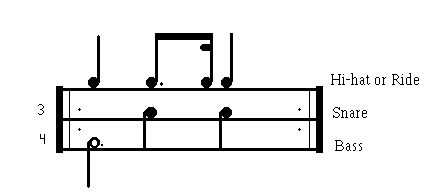
![]() This is a simple Swing Waltz. You may hear it most often with simple C&W tunes or many soft romantic, pop-ballads. This basic pattern is a total bore for most drummers, though it is the one we wind up being forced to play most often.
This is a simple Swing Waltz. You may hear it most often with simple C&W tunes or many soft romantic, pop-ballads. This basic pattern is a total bore for most drummers, though it is the one we wind up being forced to play most often.
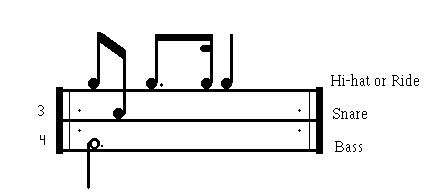
![]() Now, we toss in a quick syncopation on the snare, in-between the 1st and 2nd cymbal notes. We are leading up to something a little more interesting.
Now, we toss in a quick syncopation on the snare, in-between the 1st and 2nd cymbal notes. We are leading up to something a little more interesting.
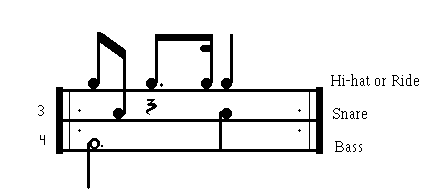
![]() This is the most basic and most common form of syncopated Swing 3/4 or Jazz Waltz.
This is the most basic and most common form of syncopated Swing 3/4 or Jazz Waltz.
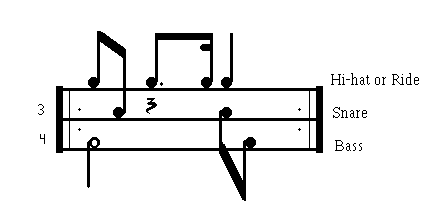
![]() There are many ways to vary the beat. Here is an example showing an additional bass note with each repetition. .
There are many ways to vary the beat. Here is an example showing an additional bass note with each repetition. .
JAZZ WALTZ is unique in that every 6/8 Blues beat could conceivably contain two repetitions of waltz. It is very common for jazz musicians to build interesting arrangements based on this principle. You will hear many jazz tunes that jump or shift from Blues into Jazz Waltz and back while maintaining the same general tempo.
![]() MIXING BLUES & JAZZ WALTZ: This sound file will give you the idea.
MIXING BLUES & JAZZ WALTZ: This sound file will give you the idea.
FILLS: When dropping fills into the above Jazz Waltz pattern it may be best to begin your fills on the 1st count of the measure as you are learning. Use any roll pattern you wish. Play three groups of your roll beginning on the first count of the bar. This will bring you out to the first count of the next bar. Later, you may experiment with dropping fills on the 2nd or 3rd count in the measure. It really doesn't matter what you play as a fill, nor where you begin. The trick is to never lose track of the count.
![]() VIDEO: Click here to 'Play', see, and hear a short solo using the tips in this lesson.
VIDEO: Click here to 'Play', see, and hear a short solo using the tips in this lesson.
Your measure of yourself is VERY IMPORTANT! How do you measure up as a person? This may offer a clue!
Finite To Infinity
3 very important questions
IS IT POSSIBLE THAT YOUR 'NATURAL GIFT' OF RHYTHM CAN BE DOUBLED WITH ONLY A LITTLE ADDITIONAL (PREVIOUSLY UNAVAILABLE), KNOWLEDGE?
IS THERE A 'KNOWLEDGE GAP' IN YOUR OWN UNDERSTANDING OF 'RHYTHM'?
IS IT POSSIBLE TO GAIN A COMPLETE AND THOROUGH UNDERSTANDING OF 'ALL RHYTHM', WITHIN ONLY A COUPLE HOURS OF EASY, AND FASCINATING, STUDY ?
Answers: YES! YES! YES!
Get All Products Here
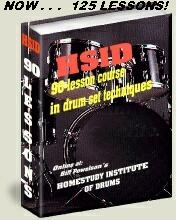
GET ALL THE PRODUCTS AT ONE LOW PRICE.
SURPRISES ABOUND!!!! . . . For those with a bit of generosity in their soul.
CLICK HERE , to see what I mean.
Intermediate & Advanced Drummers
- Drum Instructors Wanted
- Teach My Lessons and Methods
- Up to $60.00/hour
Pre-School Drummer?
Can we teach rhythm to pre-schoolers? YES!
This is a very short course, designed to help adults plant the seeds of rhythm into children of nearly any age. Click Here!!
Make CASH $$$ Now!!!

FREE ELECTRONIC BOOK BONUS (also included) BUSINESS OPPORTUNITY:
- * MAKE BIG MONEY SELLING USED DRUMSETS!
- * INSIDER HARDBALL-BUYING-TIPS AND SECRETS.
- * UNIQUE RECOVERING SECRETS
Support Us Today!!
Support this site and and gain an advetising bargain with the deal. Place a permanent ad here.
